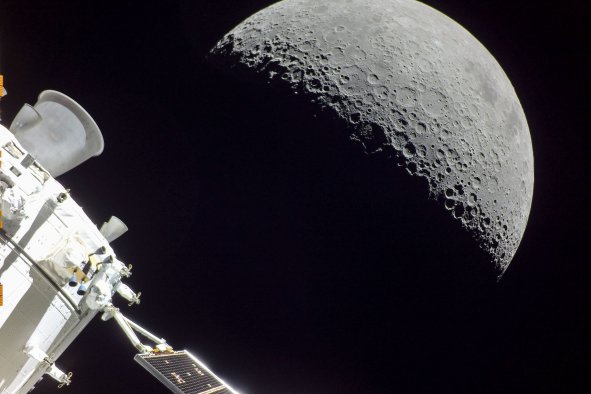An unsuspecting moon lurking in our solar system has a secret ocean of water that might even harbor extraterrestrial life, scientists have suggested.
The tiny world Miranda, one of the moons of the ice giant Uranus, may have a liquid water ocean underneath its surface, according to a paper in The Planetary Science Journal.
This places Miranda among the few bodies in our solar system that could have a form of life thriving in its water depths.
"To find evidence of an ocean inside a small object like Miranda is incredibly surprising," study co-author Tom Nordheim, a planetary scientist at Johns Hopkins University's Applied Physics Laboratory, said in a statement.
"It helps build on the story that some of these moons at Uranus may be really interesting—that there may be several ocean worlds around one of the most distant planets in our solar system, which is both exciting and bizarre," he said.
How Many Moons Does Uranus Have?
Uranus has 28 known moons, 27 of which are named, primarily after characters from the works of William Shakespeare and Alexander Pope. Miranda is the smallest of Uranus' large moons—after Titania, Oberon, Umbriel and Ariel—at about 290 miles in diameter, about one-seventh the size of our moon. It is believed to be composed mostly of water ice mixed with rock, like most of Uranus' moons, and has a patchwork surface of different types of terrain, including huge canyons, ridges and cliff faces. These features are mostly thought to have formed as a result of internal heating due to gravitational interactions with Uranus.
Now, this new research suggests that beneath its icy and rocky surface Miranda is hiding an ocean of liquid water, challenging our initial assumptions about how it formed.
In the paper, the researchers describe the way they modeled how Miranda's strange geology may have formed, reverse engineering it based on gravitational interactions with Uranus to determine what the inside of the moon must be like.
They discovered that the most likely scenario to result in Miranda's strange appearance would be if the moon had a vast underground ocean between 100 million and 500 million years ago. This ocean would have filled over half of the moon's entire body, at about 60 miles deep below a 20-mile-thick icy crust.
"That result was a big surprise to the team," co-author Caleb Strom, a graduate student at the University of North Dakota, said in the statement.
This ocean was likely created because of tidal forces between Miranda and the other moons of Uranus, which can be strengthened if the moons orbit around a planet at particular rates. These gravitational tugs heat the inside of a moon, melting ice into liquid water. This process is thought to be why Jupiter's moon Europa has a subsurface ocean too.
The moons of Uranus have since desynchronized from the orbital resonances that would have created the ocean, meaning that the ocean has likely frozen significantly since the formation of the moon's strange surface formations. However, according to the researchers, the ocean may not yet have entirely frozen, with some liquid water still lurking beneath the surface.
"The suggestion of an ocean inside one of the most distant moons in the solar system is remarkable," Strom said.
Another solar system moon, Saturn's Enceladus, was discovered in 2004 to have a subsurface ocean, which has now pegged the moon as a prime candidate for life beyond our planet.
"Few scientists expected Enceladus to be geologically active," co-author Alex Patthoff, a researcher at the Planetary Science Institute in Arizona, said in the statement. "However, it's shooting water vapor and ice out of its southern hemisphere as we speak."
Therefore, Miranda may also one day be a target for the search for extraterrestrial life. However, much more research needs to be done to find out if the ocean is still liquid or if it ever existed at all.
"We won't know for sure that it even has an ocean until we go back and collect more data," Nordheim said. "We're squeezing the last bit of science we can from Voyager 2's images. For now, we're excited by the possibilities and eager to return to study Uranus and its potential ocean moons in depth."
Do you have a tip on a science story that Newsweek should be covering? Do you have a question about moons? Let us know via science@newsweek.com.
Reference
Strom, C., Nordheim, T. A., Patthoff, D. A., & Fieber-Beyer, S. K. (2024). Constraining Ocean and Ice Shell Thickness on Miranda from Surface Geological Structures and Stress Modeling. The Planetary Science Journal, 5(10), 226. https://doi.org/10.3847/psj/ad77d7
Disclaimer: The copyright of this article belongs to the original author. Reposting this article is solely for the purpose of information dissemination and does not constitute any investment advice. If there is any infringement, please contact us immediately. We will make corrections or deletions as necessary. Thank you.



